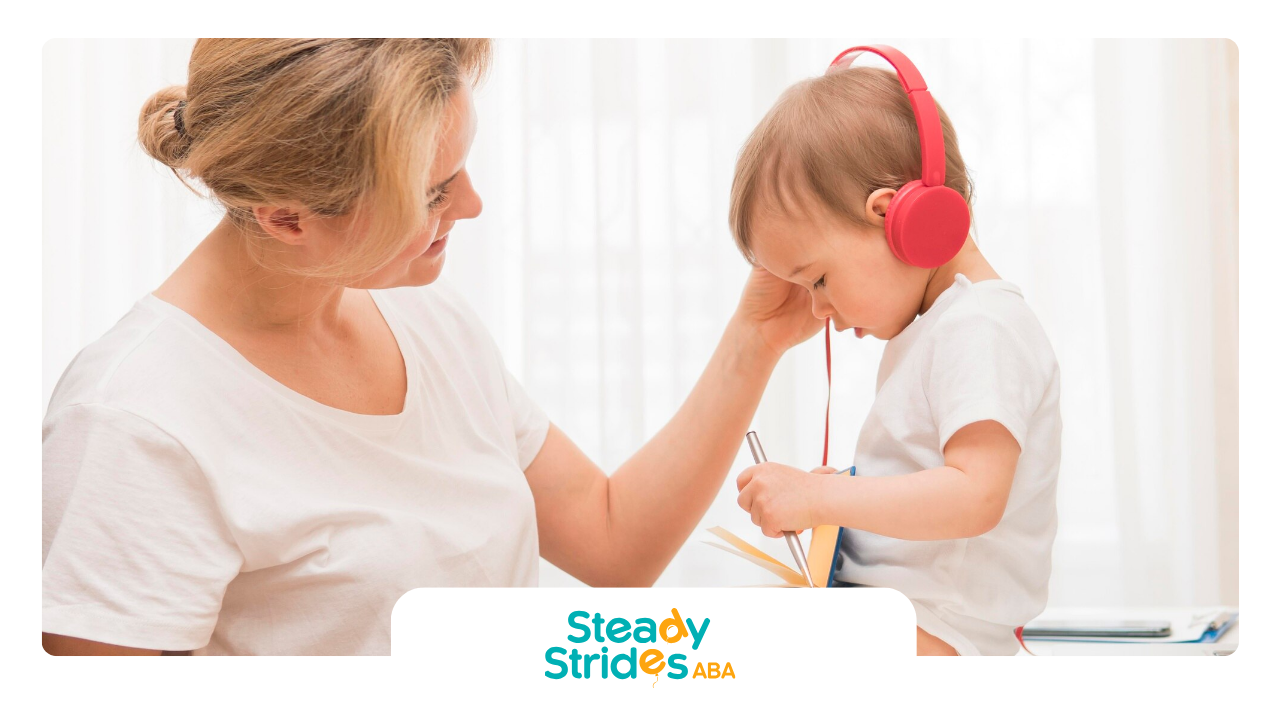Key Highlights
- Noise canceling headphones can significantly improve the quality of life for individuals on the autism spectrum by sensory overload and creating a more peaceful environment.
- Active noise cancellation technology in headphones helps to block out background noise and improve focus, making it easier for autistic adults concentrate on tasks.
- It is important to select headphones that provide high-quality sound and comfort, as well as the right fit for sensory sensitivities. Ear defenders or ear muffs can be used in place of traditional headphones for those who prefer a different style.
- Durability and battery life are key factors to consider when choosing noise canceling headphones for daily use. Wireless headphones offer convenience and freedom of movement, while wired headphones may provide better functionality for autistic children.
- Adjustable volume limits are essential to protect hearing, and lightweight designs can reduce head pressure for individuals on the autism spectrum. Easy-to-use controls and compatibility with assistive devices and apps are additional features to look for in autism-friendly headphones.
Introduction
Living with autism brings its own set of challenges, and one of the most common difficulties faced by individuals on the autism spectrum is sensory sensitivity. Many people with autism experience sensory overload, where everyday sounds and noises can become overwhelming and cause distress. Noise canceling headphones have emerged as a valuable tool for managing sensory sensitivities and improving the quality of life for those on the autism spectrum.
By using advanced noise cancellation technology, these headphones can effectively block out background noise, creating a more peaceful and calm environment. Whether it's buzzing appliances, traffic noise, or the chatter of a crowded room, noise canceling headphones can help individuals with autism regain control and find comfort in their surroundings.
In this ultimate guide, we will explore the benefits of noise canceling headphones for individuals with autism. We will delve into the key features to look for when selecting autism-friendly headphones, as well as provide practical tips for introducing and incorporating headphones into daily routines. Additionally, we will address frequently asked questions to provide a comprehensive understanding of noise canceling headphones and their role in supporting individuals on the autism spectrum.
Exploring the Best Noise Canceling Headphones for Individuals with Autism
When it comes to finding the best noise canceling headphones for individuals with autism, there are a few key factors to consider. In this section, we will explore the importance of sound quality and comfort, the benefits of active noise cancellation technology, selecting headphones with the right fit for sensory sensitivities, and understanding durability and battery life for daily use. We will also compare the advantages of wireless and wired headphones and provide a helpful text table for easy reference.
1. The Importance of Sound Quality and Comfort
When considering noise canceling headphones for autistic individuals, the importance of sound quality and comfort cannot be overstated. High-quality sound reproduction and comfortable wear are crucial in providing a positive listening experience and minimizing sensory overload. The headphones should deliver clear audio without distortion, allowing the user to enjoy their favorite sounds or music without being disturbed by background noise. Comfort is equally vital to ensure extended wear without causing discomfort or pressure on the ears, making it easier for individuals to focus and engage with their surroundings. Prioritizing these features can significantly enhance the quality of life for autistic individuals in a noisy world.
2. How Active Noise Cancellation Enhances Focus
Active noise cancellation (ANC) technology plays a crucial role in enhancing focus for individuals with autism. By reducing environmental distractions and background noise, ANC headphones create a more conducive listening environment. This reduction in external stimuli can help mitigate sensory overload and improve attention span. The ability of ANC to block out irrelevant sounds enables autistic individuals to concentrate better on tasks at hand. The technology effectively minimizes the impact of loud noises, making it easier for them to engage in activities without being overwhelmed. This feature of ANC headphones significantly contributes to enhancing focus and overall quality of life for individuals on the autism spectrum.
3. Selecting Headphones with the Right Fit for Sensory Sensitivities
When choosing noise-canceling headphones for individuals with sensory sensitivities, it's crucial to prioritize the right fit. Opt for headphones with soft padding and adjustable headbands to ensure comfort without causing sensory overload. Look for lightweight designs to minimize head pressure and consider ear cup sizes that fit snugly without exerting too much pressure. Customizable settings for ear cups and headbands can cater to specific sensory needs, providing a comfortable listening experience. Selecting headphones that accommodate sensory sensitivities can significantly enhance the user's comfort and make a positive impact on their overall experience with noise canceling technology.
4. Understanding Durability and Battery Life for Daily Use
When choosing noise canceling headphones for autistic individuals, considering durability and battery life is crucial for daily use. Opt for headphones that are robust enough to withstand regular wear and tear, especially if they will be used frequently. Ensure the battery life is sufficient to last throughout the day, providing uninterrupted sensory relief when needed. By understanding the durability of the headphones and their battery performance, you can ensure a reliable tool in managing sensory sensitivities in various environments. Selecting headphones with optimal durability and long-lasting battery life can significantly enhance the overall user experience and effectiveness in reducing auditory distractions.
5. Wireless vs. Wired: Which is Better for Your Needs?
When choosing between wireless and wired headphones for individuals with autism, consider the freedom of movement wireless provides versus the reliability of a wired connection. Wireless may offer convenience, while wired ensures constant connectivity. Assess your needs based on mobility and consistent audio transmission.
Key Features to Look for in Autism-Friendly Headphones
When selecting autism-friendly headphones, it's important to consider specific features that cater to the needs of individuals on the autism spectrum. In this section, we will explore key features such as adjustable volume limits to protect hearing, lightweight design to reduce head pressure, easy-to-use controls for independent operation, and compatibility with assistive devices and apps. By prioritizing these features, individuals with autism can find headphones that enhance their listening experience and support their unique sensory needs.
1. Adjustable Volume Limits to Protect Hearing
When selecting noise-canceling headphones for autistic individuals, prioritizing features like adjustable volume limits can significantly benefit their sensory experience. By setting volume restrictions, it helps protect their hearing from loud noises that may trigger sensory overload. These limits provide a controlled listening environment, allowing individuals to enjoy their audio content without the risk of exposure to harmful sound levels. Protecting their hearing is crucial for maintaining their sensory well-being and overall comfort while using headphones. Additionally, adjustable volume limits offer caregivers peace of mind, knowing that their loved ones are engaging with audio at safe and comfortable levels, enhancing their overall quality of life.
2. Lightweight Design to Reduce Head Pressure
Selecting noise-canceling headphones with a lightweight design is crucial for reducing head pressure in individuals with autism. Heavy headphones can cause discomfort and sensory overload, making it challenging to wear them for extended periods. By opting for a lightweight model, you can provide a more comfortable and manageable sensory experience. Additionally, lightweight headphones help in preventing strain on the neck and head, promoting prolonged usage without causing discomfort. This design feature can make a significant difference in the overall comfort and usability of the headphones for individuals with autism, enhancing their listening experience and improving their quality of life.
3. Easy-to-Use Controls for Independent Operation
When selecting noise canceling headphones for autistic individuals, considering easy-to-use controls for independent operation is crucial. Simple and intuitive control buttons or touchpads can empower users to adjust settings effortlessly, promoting a sense of autonomy. This feature enhances the overall experience, allowing users to navigate through different modes or volume levels without assistance. Additionally, easy-to-use controls contribute to a positive user experience, minimizing frustration and maximizing comfort. By prioritizing headphones with accessible controls, individuals with autism can personalize their listening environment according to their preferences, promoting independence and self-regulation.
4. Compatibility with Assistive Devices and Apps
When considering noise canceling headphones for autistic individuals, compatibility with assistive devices and apps is crucial. Ensuring that the headphones can seamlessly integrate with existing communication tools or sensory support apps is a significant factor in enhancing the overall user experience. By utilizing headphones that work harmoniously with assistive devices, individuals can navigate their environment with more ease and comfort. Look for headphones that offer versatile connectivity options and are compatible with a wide range of devices to maximize usability and functionality. This compatibility can make a profound difference in how effectively the user can engage with their surroundings and manage sensory inputs.
Practical Tips for Introducing Headphones to Individuals with Autism
Introducing headphones to individuals with autism requires a thoughtful and gradual approach to ensure a smooth transition. In this section, we will provide practical tips for gradually introducing headphones to avoid overwhelm, using favorite sounds or music as positive reinforcement, and creating a safe and comfortable listening environment. By following these tips, caregivers can help individuals with autism develop a positive association with headphones and incorporate them into their daily routines.
1. Gradual Introduction to Avoid Overwhelm
When introducing noise-canceling headphones to individuals with autism, it's crucial to proceed gradually to prevent overwhelming sensory experiences. Start by introducing the headphones in short intervals, gradually increasing the duration as comfort improves. Using familiar sounds or preferred music can serve as positive reinforcement during the introduction phase. Creating a safe and comfortable listening environment is key; ensure minimal distractions and adjust settings based on individual preferences. By easing into the use of noise-canceling headphones, you can help individuals with autism adapt at their own pace, minimizing the risk of sensory overload and fostering a positive association with this beneficial technology.
2. Using Favorite Sounds or Music as Positive Reinforcement
One effective strategy for individuals with autism is using favorite sounds or music as positive reinforcement. This method can help create a positive association with wearing noise-canceling headphones, making them more likely to embrace this tool for sensory regulation. By incorporating familiar and enjoyable sounds, such as calming music or comforting noises, individuals can feel more at ease and comfortable wearing the headphones. Positive reinforcement techniques like this can play a crucial role in acclimating autistic individuals to new experiences and tools, leading to a smoother transition and increased acceptance of noise-canceling headphones into their routines.
3. Creating a Safe and Comfortable Listening Environment
Individuals with autism benefit greatly from a safe and comfortable listening environment when using noise-canceling headphones. Creating such an environment involves minimizing distractions and ensuring a peaceful setting. Dimming lights, using soft cushions, and controlling room temperature can enhance comfort. Additionally, establishing a predictable routine can help reduce anxiety and promote relaxation during headphone use. It's essential to consider individual sensory preferences and adjust the environment accordingly to optimize the experience. By prioritizing a calming atmosphere, individuals with autism can better enjoy the benefits of noise-canceling headphones and improve their overall listening experience.
Conclusion
In conclusion, noise-canceling headphones can significantly benefit individuals with autism by providing a comfortable and focused auditory experience. When selecting headphones, consider factors like sound quality, comfort, and sensory sensitivities to ensure a positive user experience. Introducing headphones gradually, using favorite sounds, and creating a safe listening environment are practical tips for successful adoption. By understanding the technology behind noise cancellation and incorporating headphones into daily routines, caregivers can enhance the well-being of individuals with autism. For more information on assistive audio devices for autism, explore additional resources available.
Frequently Asked Questions
How Do Noise-Canceling Headphones Benefit Autistic Individuals?
Noise canceling headphones benefit autistic individuals by reducing sensory overload and creating a more peaceful and controlled listening environment. This can lead to improved focus, reduced anxiety, and an overall better quality of life for individuals on the autism spectrum.
Can Noise-Canceling Headphones Help with Sound Sensitivity?
Yes, noise-canceling headphones can help with sound sensitivity in individuals with autism. By reducing background noise and providing a quieter environment, noise-canceling headphones can minimize the impact of sound sensitivity and create a more comfortable listening experience.
What Should I Consider When Choosing Headphones for a Child with Autism?
When choosing headphones for a child with autism, consider factors such as noise cancellation, comfort, and durability. Look for headphones that provide effective noise reduction, have a comfortable fit, and can withstand daily use and potential rough handling.
Are There Any Risks Associated with Using Noise Canceling Headphones?
While noise canceling headphones are generally safe to use, it's important to be aware of potential risks. Prolonged exposure to loud noises can still be harmful, so it's crucial to set appropriate volume limits and ensure the headphones provide sufficient hearing protection.
How Often Should Noise Canceling Headphones Be Used?
The frequency of using noise canceling headphones depends on individual needs and preferences. Some individuals with autism may benefit from using them daily to create a more peaceful and controlled listening environment, while others may use them as needed in specific situations with high ambient noise.
Can These Headphones Be Used in Educational or Therapeutic Settings?
Yes, noise canceling headphones can be used in educational or therapeutic settings to help individuals with autism maintain focus and reduce distractions. They can be a valuable tool for enhancing concentration and creating a more conducive learning or therapeutic environment.
What is the Difference Between Noise Canceling and Noise Isolation Headphones?
The main difference between noise canceling and noise isolation headphones lies in their technology. Noise canceling headphones use advanced technology to actively cancel out external noise, while noise isolation headphones rely on physical barriers such as ear cups to block out background noise. Noise canceling headphones are generally more effective in reducing background noise and providing a higher quality listening experience.
How Can Caregivers Ensure the Headphones are Used Safely and Effectively?
Caregivers can ensure the safe and effective use of noise canceling headphones by setting appropriate volume limits, monitoring headphone usage, and providing guidance on proper care and maintenance. It is important to educate individuals with autism on headphone safety and encourage responsible use.
Are There Specific Brands or Models That are Recommended for Autism?
While there are no specific brands or models that are universally recommended for autism, some popular options among individuals with autism include Sony WH1000XM3, Bose QuietComfort 35 II, and Sennheiser Momentum 4 Wireless. It's important to consider individual needs and preferences when choosing the right headphones.
Tips for Maintaining and Cleaning Headphones to Ensure Longevity
To ensure the longevity of noise canceling headphones, it's important to maintain and clean them regularly. Here are some tips:
- Avoid exposing headphones to excessive moisture or extreme temperatures.
- Clean the ear cups and headband with a soft cloth or mild cleaning solution.
- Store headphones in a protective case when not in use to prevent damage.
- Replace ear cushions or foam pads if they become worn or damaged.
- Avoid pulling or twisting the headphone cables, as this can lead to connectivity issues.
By following these tips, individuals can prolong the lifespan of their noise canceling headphones and ensure optimal performance for years to come.
Understanding the Technology Behind Noise Cancellation
Noise cancellation technology is designed to reduce unwanted background noise and create a quieter listening environment. Active noise cancellation (ANC) technology, commonly found in noise canceling headphones, uses built-in microphones to detect external sounds. The headphones then generate inverse sound waves that cancel out the incoming noise, effectively reducing its impact. ANC headphones continuously monitor and adjust the cancellation process in real-time, providing a more immersive and peaceful listening experience. By understanding the technology behind noise cancellation, individuals with autism can make informed decisions when selecting headphones and benefit from the advanced features and capabilities they offer.
Strategies for Incorporating Headphones into Daily Routines for Autistic Individuals
Incorporating noise canceling headphones into daily routines can be a beneficial strategy for autistic individuals. Here are some strategies to consider:
- Introduce headphones gradually and in a positive way, using favorite sounds or music as reinforcement.
- Establish a consistent routine for headphone use, such as during specific activities or times of day.
- Encourage self-advocacy and independence by teaching individuals to use and adjust the headphones on their own.
- Create a designated space or area where individuals can comfortably use their headphones, free from distractions.
- Regularly communicate with individuals and assess their comfort and satisfaction with the headphones to ensure they are effectively meeting their needs.
By incorporating noise canceling headphones into daily routines, individuals with autism can experience a higher quality of life and improved ability to manage sensory sensitivities.
Resources for Further Information on Assistive Audio Devices for Autism
For further information on assistive audio devices for autism and noise cancellation, there are several resources available. These include:
- Autism organizations and support groups:
Organizations such as
Autism Speaks and the
National Autistic Society provide information and resources on assistive technology for individuals with autism.
- Audiologists and hearing specialists:
Professionals in the field of audiology can provide guidance on noise canceling headphones and other assistive audio devices.
- Online forums and communities: Online communities and forums dedicated to autism and sensory processing disorders often have discussions and recommendations on noise canceling headphones.
- Product reviews and comparison websites: Websites such as Consumer Reports and CNET provide detailed reviews and comparisons of noise canceling headphones, offering valuable insights for individuals with autism and their caregivers.
By utilizing these resources, individuals with autism and their caregivers can access helpful information and make informed decisions when choosing assistive audio devices.












